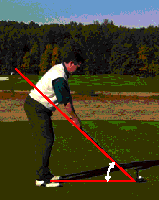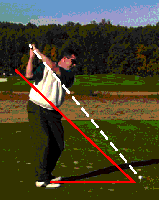|
|
Golf Tip: 10 More Yards With Every Club
by
Golfers have searched for the secret of the golf swing since the beginning of the game. Oddly enough, the secret has been right in front of us all the time - the club is the master model for the swing.
The club is designed with a lie angle, and it is this angle that sets up the shape of the golf swing. At address, the club is square to the target (if you're aimed correctly), and the shaft forms an angle with the ground called the lie angle.
Golf ball hitting machines like Iron Byron fix the club and swing it back and through on this angle. The club never varies from its original angle throughout the swing, so the machine is able to hit perfect shots, time after time.
A line drawn under the shaft represents the ideal angle or swing plane on which the club should travel. Think of this line as a board or pane of glass that the club could slide along.
Here's the problem. Unlike a golf ball hitting machine that can keep the club perfectly on plane throughout the swing, a human being cannot stay on the same plane and make a full golf swing. Instead, about halfway into the backswing, our hands and club shift to a second, more vertical plane than the original.
This new plane is above or over the top of the original plane, and unless we return to the original plane, the downswing will be "over the top" - the most common swing flaw in golf.
The difficulty with the golf swing is that this plane shift is imperceptible because it's built into the way our body moves. Therefore, it doesn't occur to us to return the club back to the original plane. Instead, we swing right at the ball, on a clearly different plane from the original, which causes slices, pulls, pop-ups, fat shots and a lack of distance. Sound familiar? The first move you make as you start down determines whether or not you get back on plane.

If you're aimed correctly at address with the club square to the target, the shaft forms an angle with the ground called the lie angle. Ideally, your club should never vary from this original angle throughout the swing.

Unfortunately, golfers are human and cannot stay on the same plane (red line) and make a full swing. Instead, about half way into the backswing, the club shifts to a second, more vertical plane (white line) than the original. This shift brings the club up over the top of the original plane, causing poor shots.
back |
|